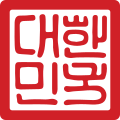Seal of South Korea
| National Seal of the Republic of Korea 대한민국의 국새 | |
|---|---|
 | |
| Armiger | Republic of Korea |
| Adopted | 25 October 2011 (inaugural version from 5 May 1949) |
| Motto | 대한민국 |
The National Seal of the Republic of Korea (Korean: 대한민국의 국새) is a governmental seal used for purposes of state in South Korea.[1][2] The seal is carved with characters called injang.[1]
Since the late 20th century the seal's design consists of South Korea's official name written in Korean characters inside of a square; during the 20th century Chinese characters were used.
History
Following the establishment of the South Korean state in August 1948, its government adopted in May 1949 a new state seal, or guksae (Korean: 국새; 國璽). It is used in promulgation of constitution, designation of cabinet members and ambassadors, conference of national orders and important diplomatic documents.[3]
The seal's design has been modified multiple times over the years. The first version of the seal, used until the early 1960s, used Hanja characters.[3] In the late 20th century, the lettering was changed to use only Korean characters.[3]
The current seal is the fifth version and was designed in September 2011, being adopted in October 2011.[3]
Previous seals
-
National seal (1949–1962)
-
National seal (1963–1999)
-
National seal (1999–2008, 2010–2011)
-
National seal (2008–2010)
See also
- Imperial Seal of China
- Cash seal (China)
- Seal script
- Seal cutting (art)
- Seal engraving (art)
- Seal knob
References
- ^ a b Cheon, Jingi (Summer 2008). "Guksae (State Seal) Consummate Work of Korea's Master Craftsmen" (PDF). Koreana. 22.
- ^ "Pembuatan Segel Nasional Korea Selatan yang baru" [The Making of a new South Korea National Seal] (in Indonesian). KBS World (Indonesia). 14 February 2006. Archived from the original on 6 March 2012. Retrieved 2 June 2010.
{{cite web}}: Unknown parameter|deadurl=ignored (|url-status=suggested) (help) - ^ a b c d Ministry of the Interior of the Republic of Korea (2017). National Symbols of the Republic of Korea: Uniting People and Elevating National Pride. Seoul: Ministry of the Interior of the Republic of Korea. pp. 12–13. Retrieved 6 August 2017.




